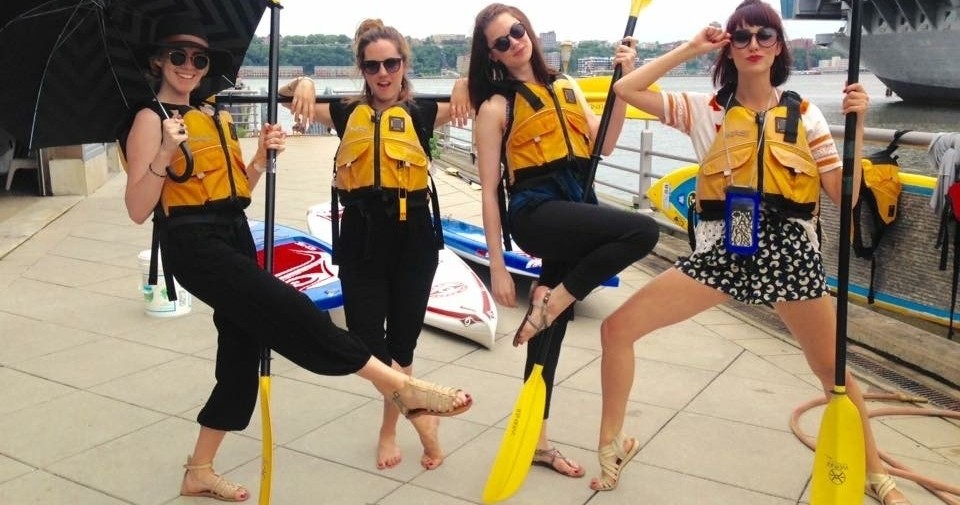What to Wear & Bring During Summer

Don’t let cotton underwear ruin your day.
If you’re dressed right, you’ll stay dry, warm, and enjoy your time on the water. We often say “dress for immersion” because if you end up in the water, you’ll be safe and not soggy. Here’s how we dress in the summer…based on real-life experience from thousands of paddlers.
Wear a Life Jacket
We provide life jackets and everyone should wear one. It keeps your body afloat if you fall in. Our life jackets are “Harmonized Level 70”, that’s the current U.S. and Canada standard for recreational kayaking. We use high-visibility color like orange, yellow, or green. After use, we rinse them with fresh water, let them dry fully, and store them indoors.
What To Wear From May 1 to Oct 31
When the water temperature in NYC is above 60F, wear easy athletic clothes. All our beginner activities run during this time. Most beginners splash themselves without realizing it. Expect to get wet and bring extra clothes.
• Splash Jacket: We supply these if you need them. Wear one to stay warm around sunset or if it’s a windy or chilly day.
• Quick-Dry Clothing: Polyester is ideal. Most athletic clothes are made of this fabric. Look for recycled poly if you can.
• Sun Protection: For UV coverage, wear long sleeves and a brimmed hat that’s snug or has a chin strap.
• No Cotton: Even 10% cotton clings to skin and stays wet. If you paddle regularly, remove the cotton from your paddling drawer.
• No Flip-Flops or Bare Feet: Wear sandals with a real sole (like Teva, Keen, Chaco, Crocs), neoprene water shoes, or sneakers you don’t mind getting wet. Water socks are too thin to protect your feet from sharp objects.
What To Wear From Nov 1 to April 30
We cannot wear street clothes when the water temperature is below 60F. We have a full blog on what to wear after summer if you’re ready.
Wearable Gear
Some gear is only useful if it’s on your body. Once it’s stowed away, it’s hard to reach. Keep these essential items attached to your body or within arm’s reach.
🕶️ Sunglasses
Paddle trips are notorious for eating sunglasses. Look for polarized, scratch-resistant, UV-coated lenses, saltwater-resistant parts, and a floating frame. Use a sunglasses strap to keep them out of the water.
📱 Cell Phone in a Waterproof Case
If you must take your cell phone, use a waterproof case with a tether or carabiner or zip it into your life jacket. We rent waterproof phone cases if you need them. For paddling alone, a smartphone is essential for navigating new waters, checking the radar, or calling for help.
📻 VHF Radio
All of our river guides carry one. It’s an essential tool for alerting other boats to your presence or calling for help. If you paddle alone, carry one that’s fully charged, turned to Channel 13 to talk to commercial boats and Channel 16 to talk to the Coast Guard, and securely attached to your life jacket with a lanyard and S-carabiner.
🔊 Whistle
A whistle is an easy way to call for help. It never runs out of battery and works even if you’re not visible. Every life jacket should have one, and many life jackets come with built-in whistles (like ours).
🔦 Flare or Signal Mirror
If you’re paddling alone, carry a flare (great for night) or a signal mirror (for daytime only). This helps rescuers find you from a distance. If you’re paddling solo, carry one in your PFD pocket.
💧 Hydration System
A water bottle suffices for trips up to 3 hours. Beyond that, we recommend getting a hydration bladder to sip anytime through a hose. Use a carabiner or leash to connect the water bladder to your deck’s bungee cords.
☀️ Sunscreen
A small container of sunscreen in your pocket makes it easy to reapply during long paddles. It’s also something worth sharing with others. Choose marine-safe sunscreen. We love the flat tins of Badger Adventure 50.
🍬 Quick Energy
If you’re paddling for hours, stash a snack or energy chew in your life jacket. A small sugar boost can help keep your energy up when you need it.
🔪 Knife
If you’re paddling alone, a compact stainless-steel utility knife is essential for cutting yourself or someone else free. Keep it within reach, mounted to your life jacket, and easy to open quickly. Fishing lines are invisible and can catch you if you paddle too close to shore, and unexpected water dynamics can cause tangle-ups.
Final Word
The right clothing can make the difference between a great day and a soggy one. What you wear matters for both safety and comfort. With the right setup, you’ll be prepared to for many challenges that can come your way. If you’re unsure, just reach out. We’re here to help.
